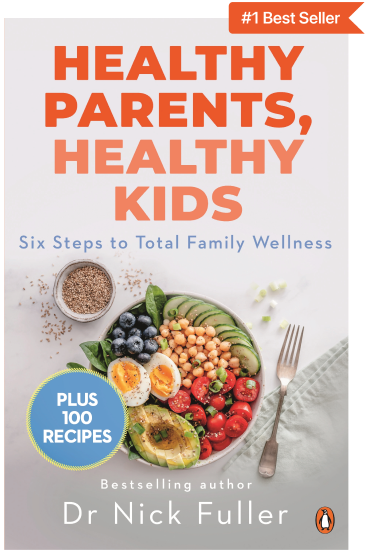How to Deal With Toddlers Who Refuse Milk

Dr Nick Fuller
Leading Obesity Expert at the University of Sydney and founder of Interval Weight Loss.

Getting your toddler to drink milk can sometimes feel like trying to convince a cat to take a bath: tricky, messy, and downright frustrating. But you’re not alone. Many Aussie parents face the same challenge. A 2021 study found that only about 64% of toddlers aged 13 to 36 months were given cow’s milk, with many also offered other milk types, showing there’s quite a bit of variety in what little ones actually drink.
Early exposure to milk and dairy products can help shape your toddler’s taste preferences and support their intake of key nutrients like calcium, vitamin D, and protein, which are important for strong bones and healthy growth. But when milk isn’t part of their regular routine early on, some kids may become less open to drinking it later.
The good news? Whether your child is simply uninterested or flat-out refusing, there are practical, low-stress ways to encourage a healthier relationship with milk. These tips can help you navigate the picky phase and keep your toddler nourished and hydrated without the daily struggle. Let’s dive in.
Need Practical Parenting Strategies That Actually Work?
In Healthy Parents, Healthy Kids, Dr Nick Fuller shares practical, no-pressure strategies to help you navigate mealtimes without the power struggles. From nutrition tips to real-life routines, this book is packed with expert advice to support your toddler’s health and your sanity.
Grab your copy of Healthy Parents, Healthy Kids today.
Why Toddlers Refuse Milk
Toddlers often refuse milk for a variety of reasons:
Taste Changes
Toddlers’ taste buds are on a wild ride. What was a favourite yesterday can suddenly become ‘yuck’ today. Between 12 and 24 months, kids experience rapid shifts in taste preferences, which often leads to rejecting foods they once loved, including milk. Research shows that this phase of neophobia (fear of new or disliked foods) affects up to 50% of toddlers, making taste changes a common hurdle for parents.
Teething or Mouth Pain
Cutting molars and sore gums can make even sipping milk uncomfortable. Teething can cause mouth sensitivity and impact both eating and drinking habits. Cold or even room-temperature milk might feel unpleasant, so this phase often leads to temporary milk refusal.
Full from Other Foods or Snacks
If your toddler snacks on too many treats or drinks lots of juice during the day, they might simply be too full to want milk at mealtimes. Limiting milk intake to prevent it from crowding out iron-rich foods, but it’s important to balance this both ways. Too many snacks can reduce appetite for milk and meals alike.
Preference for Other Drinks
Flavoured waters, fruit juices, or smoothies often taste way more exciting than plain milk. Toddlers quickly learn what they like and aren’t shy about demanding it. Keep in mind, the Australian Dietary Guidelines recommend limiting sugary drinks for toddlers to protect dental health and encourage a taste for natural flavours like milk.
Texture or Temperature Issues
Some toddlers find milk’s texture ‘too thick’ or 'too bland,' while others dislike how cold it feels. Sensory sensitivity is common at this age, with up to 20-33% of children refusing certain food textures, particularly harder ones like leafy, rubbery, or foods with skin. Even small changes in temperature or consistency can make all the difference in whether milk gets a thumbs up or down.
Past Illness Linked to Milk
If your toddler once felt sick, like vomiting or diarrhoea after drinking milk, even if milk wasn’t the cause, they might associate it with feeling unwell and avoid it. This kind of negative association can linger, making milk refusal a protective behaviour.
Desire for Independence
According to UNICEF, toddlers start showing more independence and expressing preferences around 18 months, including about what they eat and drink. By 2 years old, they may become even more independent and defiant, making mealtimes more challenging for parents.
Refusing milk can be their way of saying, 'I’m in charge!' Encouraging choice and offering milk in fun, low-pressure ways can help them feel empowered while still getting the nutrients they need.
Is Drinking Milk Necessary for Toddlers?
Milk often gets a starring role in toddler nutrition, but is it really the only option? The truth is, while milk is a handy way to deliver important nutrients like calcium, vitamin D, protein, and healthy fats, toddlers can get these nutrients from a variety of other foods too. The Australian Dietary Guidelines recommend about 1 1⁄2 serves of dairy or dairy alternatives each day, which can include cheese, yoghurt, or fortified plant-based options like soy or almond milk.
What matters most is a balanced diet rich in calcium and vitamin D to support growing bones, not necessarily milk itself. So, if your little one isn’t keen on milk, don’t stress. There are plenty of tasty, nutritious ways to keep them strong and healthy.
Signs of Lactose Intolerance in Toddlers
Sometimes, milk refusal is more than just picky eating. Keep an eye out for these common signs of lactose intolerance:
- Bloating
- Gas
- Diarrhoea
- Stomach pain or cramps
- Nausea
- Fussiness after consuming dairy
- Loose stools
- Frequent crying after meals
- Refusal to eat dairy products
Mild lactose intolerance is common and often manageable with smaller portions or dairy alternatives. If symptoms persist, check with your GP or a paediatric dietitian.
Tips to Deal With Toddlers Who Refuse Milk
There are plenty of creative ways to make milk more appealing without the stress. Here are some practical tips to try out.
Offer Milk in a Fun Cup or with a Straw
Sometimes, it’s all about the presentation. Letting your toddler choose a colourful cup or a bendy straw can turn milk time into a fun, special event. When kids feel involved and excited about their 'special milk cup,' they’re more likely to drink up without fuss.
Mix Milk with Smoothies or Oatmeal
If plain milk isn’t cutting it, try blending it into a delicious smoothie with natural sweetness from banana, berries, or other favourite fruits. You can also pour milk over porridge or Weet-Bix for a creamy, nutrient-packed brekkie that’s easy to enjoy. These tasty options sneak in milk’s goodness without the struggle.
Looking for tasty ways to sneak more milk into your toddler’s day? Check out these 4 no-fuss fruit smoothie recipes perfect for picky eaters.
Add Small Amounts of Flavour (Like Fruit Purée)
Instead of sugary syrups, try adding natural flavours like mango purée, cinnamon, or vanilla extract to milk. These subtle flavour boosts can make milk more interesting and appealing, without loading it with unnecessary sugar or additives. It’s a gentle way to tempt picky taste buds.
Use Milk in Cooking or Baking
Milk isn’t just for drinking. Incorporate it into meals by adding it to soups, pasta sauces, mashed potatoes, pancakes, or muffins. This sneaky approach means your toddler still benefits from milk’s nutrients, even if they refuse to drink it straight.
Keep Milk at the Right Temperature
Temperature can be a dealbreaker for some kids. While some toddlers love their milk ice-cold, others prefer it warmed up. Experiment with different temperatures to find what your child prefers. Sometimes a small change like this makes all the difference.
Avoid Forcing
Pressuring or forcing your toddler to drink milk can backfire and create long-term negative associations. Instead, keep milk available and offer it in a relaxed, low-pressure way. Patience and gentle encouragement often work better than any amount of pushing.
Offer Dairy-Rich Snacks
If drinking milk isn’t their thing, offer dairy-rich snacks like cheese cubes, yoghurt, custard, or kefir. These tasty options can help meet daily dairy needs without the stress of drinking milk, and many toddlers find them more appealing.
Want to make dairy more exciting for your little one? These 5 toddler-friendly yoghurt recipes are perfect for picky eaters and a great way to boost calcium and probiotics without the fuss.
Include Calcium-Rich Foods in Meals
Milk isn’t the only source of calcium! Leafy greens, tofu, almonds or almond butter, chia seeds, and sardines are all surprisingly rich in calcium and can be included in meals to support healthy bones. Variety is key to a balanced diet.
Limit Juice and Sugary Drinks
Too much juice or sugary drinks can fill your toddler up and reduce their appetite for milk and other nutritious foods. The Australian Dietary Guidelines recommend water as the main drink outside mealtimes to keep little tummies ready for wholesome meals and milk.
Try Different Times of Day
Sometimes it’s just about timing. If your toddler refuses milk in the morning, try offering it after lunch or as part of an afternoon snack. Playing around with when you offer milk can help find the best moment when your child is most willing to drink it.
Plant-Based Alternatives for Toddlers Who Refuse Milk
If dairy's not working, here are some milk alternatives. But always check if they’re fortified with calcium and B12:
- Almond Milk: Mild and nutty, but often low in protein unless fortified.
- Soy Milk: Closest in nutritional value to cow’s milk. Choose unsweetened and calcium-fortified versions.
- Coconut Milk: Creamy but low in protein and calcium. Best in small amounts or combined with other sources.
- Oat Milk: Naturally sweet and great for baking. Look for fortified versions.
- Rice Milk: Mild, but low in protein. Often not recommended for toddlers under 5 due to arsenic concerns.
- Hemp Milk: Good source of omega-3 fats. Look for calcium-fortified options.
- Cashew Milk: Creamy and gentle in flavour, though often low in protein.
- Pea Milk: Surprisingly high in protein and often fortified, and an emerging favourite for dairy-free kids.
How Much Milk Should Toddlers Consume in a Day?
According to the Australian Nutrient Reference Values (NRVs), children need the following calcium intake per day, not just from milk, but from all sources:
- 0-6 months: 210 mg
- 7–12 months: 270 mg
- 1–3 years: 360 mg
- 4–8 years: 520 mg
That’s roughly 1–1½ cups of milk or 2 serves of dairy a day for toddlers aged 1–3, but remember: yoghurt, cheese, fortified cereals, and tofu all help reach that target too.
Final Thoughts
If your toddler has decided milk is the enemy, don’t stress. It’s a common phase and one you can work around with a little creativity, patience and some sneaky kitchen skills.
Whether it’s offering yoghurt in fun shapes, blending milk into a fruity smoothie, or switching to calcium-rich alternatives, there are heaps of ways to keep your little one’s bones strong and their bellies happy, milk or no milk.
And remember, if you’re ever unsure, your GP or paediatric dietitian can help make sure your child’s nutritional needs are totally covered.
Discover practical, science-backed tips to handle fussy mealtimes and encourage healthier eating habits without the stress. Check out this helpful guide to turn picky phases into positive progress.
Stay informed with fresh tips, expert guidance, unique deals, and tailored support!
Meet Dr Nick Fuller
My Story
As a father, I know first-hand that raising healthy and happy children is tricky. Children are fussy, particularly at the end of the day when they are shattered. We also live in a society where companies seek to profit from what we feed our kids; incorrect and damaging advice is pushed on us and marketed towards our children, and we have no time.
But with these recipes and resources, you and your children can enjoy simple and well-founded food and lifestyle choices for lifelong health.

About Dr Nick Fuller
Dr Nick Fuller is the founder of Interval Weight Loss and is a leading obesity expert at the University of Sydney with a Ph.D. in Obesity Treatment. Dr Fuller is also the author of three best-selling books and his work been published in top ranked journals in the medical field, including JAMA, Lancet and American Journal of Clinical Nutrition.
